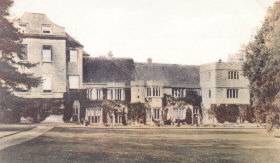
The side of Thame Park House, showing the abbot's lodging
Founded originally by Alexander, Bishop of Lincoln, the Cistercian monks at Thame Park had always been under the Episcopal authority of Lincoln, and in 1525 the then Bishop of Lincoln, John Longlands, undertook a visitation.
Thame Park was a daughter house of Waverley Abbey, and John Longlands wrote to the Abbot at Waverley complaining about the state of affairs at Thame and in particular the actions of John Warren, Abbot of Thame.
John Longlands was confessor to King Henry VIII, and such condemnations of monastic indulgence must have echoed the mood of the time at Henry's Court.
When John Warren died in 1529, the intervention of Cardinal Wolsey was sought by the Bishop of Lincoln in the matter of his successor.
Robert King was a suffragan Bishop at Lincoln, that is to say an anointed Bishop with no Episcopal duties of his own. He had himself been a Cistercian monk at Rewley Abbey, a daughter house to Thame Abbey.
It was Robert King whom the Bishop of Lincoln beseeched Cardinal Wolsey to appoint as Abbot of Thame in 1529, and this was duly done.
From 1529 onwards, things were going to be different for the white monks of Thame Park.
Robert King's brother, William King of Thame, was married to a sister of John Williams, who in 1529 was a rising star within the Court of King Henry VIII, and was destined to become Sir John Williams, Baron Williams of Thame.
John Williams was also distantly related to Thomas Cromwell, who was given the task of overseeing the Dissolution of the Monasteries by Henry VIII.
Sir John Williams was appointed visitor to the lands and houses of the Church in Oxfordshire, and in 1539 Thame Park Abbey surrendered to him, under the terms of the Dissolution.
The Abbey buildings at Thame Park were not pulled down in 1539, nor was the Abbot's lodging. They did however begin to fall into disrepair, as the monks were dispersed and the internal fixtures and fittings were removed.
Thame's St Mary's Church received much of the internal woodwork from the Abbey.
Robert King had served for ten years as the last ever Abbot of Thame Park. Two years before the Dissolution, in 1537, Sir John Williams had also secured for him the position of Abbot of Osney.
In 1541, these now defunct abbacies were transformed into the position of Bishop of Thame and Osney, which was conferred on Robert King.
Thame Park became the property of Sir John Williams, and it was inherited by the younger of his two surviving children, his daughter Isobel.
The only consecrated building within the park was now the Chapel.
Robert King
John Williams